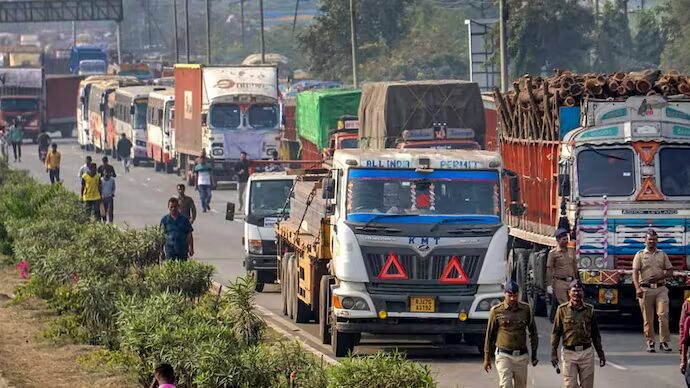The recently enacted legislation introduces more severe consequences for hit and run incidents, entailing a maximum of 10 years behind bars and a fine amounting to Rs 7 lakh. This legal framework extends its reach to encompass private vehicle proprietors as well. However, dissenting voices from the truck driver community argue that the newly implemented law is excessively harsh, characterizing it as draconian due to what they perceive as overly stringent penalties.
The recently implemented hit-and-run legislation in India, as per the Bharatiya Nyay Sanhita, establishes more stringent consequences for drivers who abscond from accident scenes. As outlined by the law, a motorist departing the scene following a hit and run incident could potentially confront a maximum sentence of 10 years in prison and a fine amounting to ₹7 lakh.
Importantly, this legal provision is inclusive of private vehicle owners. The primary objective behind this novel law is to curtail the occurrence of hit and run incidents, a factor contributing to approximately 50,000 fatalities annually in India. The repercussions for hit-and-run cases under the fresh legislation are notably harsher when juxtaposed with the preceding penalties delineated in the Indian Penal Code.
The punishment for hit and run incidents according to the recent law include:
- potential imprisonment of up to a decade(10 years)
- a monetary penalty amounting to ₹7 lakh.
Purpose Behind the Introduction of the New Hit and Run Law?
The inception of the latest hit-and-run law in India, within the Bharatiya Nyay Sanhita, is driven by a pressing need to tackle the grave issue of hit and run accidents and their ensuing repercussions. The key motivations behind the enactment of this new law include:
- Reducing Hit-and-Run Incidents: The primary objective of the new law is to curtail the prevalence of hit-and-run accidents, a menace causing approximately 50,000 fatalities annually in India.
- Enhancing Accountability: In a bid to foster accountability, the law imposes more stringent penalties for hit-and-run cases, encompassing a potential 10-year imprisonment and a ₹7 lakh fine. This move aims to hold drivers accountable for their involvement in such accidents.
- Modernizing Legal Framework: The introduction of the new law marks a departure from the antiquated British-era Indian Penal Code (IPC), ushering in comprehensive changes to the criminal justice system, including revisions to the Criminal Procedure Code (CrPC) and the Evidence Act.
- Empowering Victims: A noteworthy aspect of the new law is the empowerment of victims, granting them the right to voice their perspectives during trials. This provision strives to ensure a more equitable legal process for those impacted by hit-and-run accidents.
- Advocating Road Safety: By imposing more severe penalties for hit-and-run cases, the new law aspires to champion road safety and discourage hazardous driving behavior, thereby contributing to a safer and more responsible road environment.
Backlash of drivers Against the New Hit and Run Law:
A groundswell of dissent has erupted among truck drivers nationwide in response to the recently implemented hit-and-run law, a key feature of the Bharatiya Nyaya Sanhita that supersedes the Indian Penal Code.
Ubiquitous Resistance:
- Nationwide, truck drivers are vehemently opposing the new hit-and-run law, expressing vehement disapproval of its stringent penalties.
- The All India Motor Transport Congress is actively advocating for the law’s revocation, citing concerns of potential harassment.
Driver Apprehensions:
- Drivers argue that the law is overly draconian, asserting that the imposed fines are excessively burdensome, leading to financial struggles.
- There is a prevailing fear that the stringent penalties may dissuade existing drivers and discourage newcomers from entering the profession.
- Concerns linger over the possibility of unjust 10-year sentences stemming from false accusations or accidents beyond drivers’ control.
Ramifications of the Uprising:
- Widespread disruptions reverberate across transportation and supply chains.
- In Mumbai alone, over 70% of the estimated 1.20 lakh trucks, tempos, and containers have withdrawn from service, potentially impacting the distribution of fuel and essential goods.
- The three-day strike looms large over the distribution of fuel and essential commodities, with ripple effects extending to other regions.
- Simultaneous protests are unfolding in various parts of the country.
- The livelihoods of truck drivers and the future viability of the industry hang in the balance, as the protests underscore broader concerns regarding the fairness and unintended consequences of the legislation.
Enhancement of penalty for Hit and Run Victims Pursuant to Section 161 of the Act:-
| Circumstances | Old Penalty | New Penalty |
| Victim’s Death | ₹ 25000 | ₹ 200000 |
| Bodily Injury of the victim | ₹ 12500 | ₹ 50000 |
Hit and Run case Video on Twitter:
The new law against Hit & Run… Very well explained by this Good Policeman. Also if the fear is being beaten or lynched at the spot of accident why not just drive down to the nearest police chowkie and narrate the incident instead of running away. pic.twitter.com/jlNVQD7E9c
— मुलुंड info (@mulund_info) January 2, 2024
#TruckDriversProtest are happening across the country over the new law related to Hit & Run!
— Vijay Thottathil (@vijaythottathil) January 2, 2024
Video from instagram:
Original Credit of video: dashcam.nation

2 thoughts on “Transforming Road Safety: Unveiling the Progressive Aspects of India’s New Hit and Run Law 2023.”